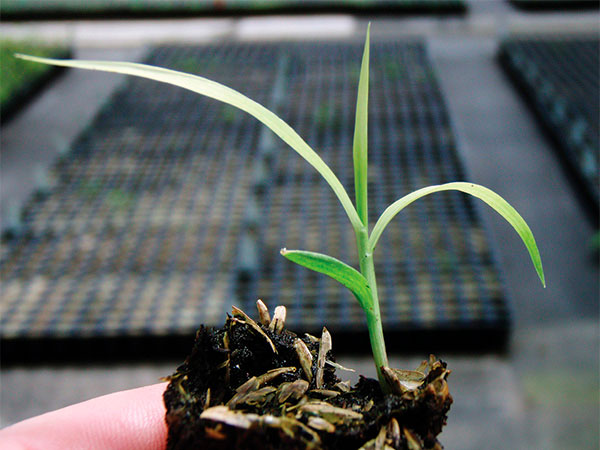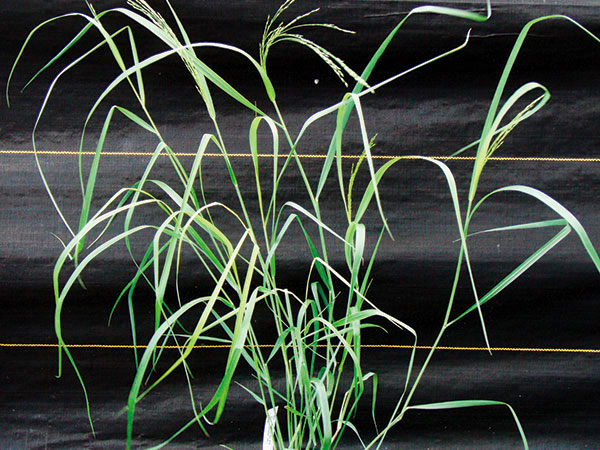In recent years, switchgrass has attracted attention as an ecologically beneficial species in conservation agriculture, and as a potential source of alternative energy and sustainable fiber for new and developing markets.


Ernst Conservation Seeds is actively involved in numerous cooperative efforts with government agencies, universities, and groups in the private sector that are interested in increasing the use of native warm season grass biomass in many applications.
Biomass production from switchgrass can vary greatly from one region to another. It is important to select switchgrass varieties that are well-suited to the growing conditions of your area. Please contact us and we will be happy to make recommendations.


Biomass production can be enhanced with the use of treated seed to control seedling disease and insect damage.
Ernst Conservation Seeds is permitted to treat switchgrass with Gaucho® XT, which reduces the need for the use of herbicides to control competitive weeds. It also increases first-year biomass production. Many states allow atrazine, at 1 lb per acre, to control many broadleaf and grassy weeds. Annual grasses can be controlled with the addition of Paramount® Herbicide. Other herbicides are available for specific conditions.
Panicum virgatum
Switchgrass
A native herbaceous perennial used for biomass in addition to soil stabilization on strip mine spoils and dikes and in buffer strips for nutrient update; provides pasture and hay for cattle and sheep; a source of food and cover for wildlife.
Andropogon gerardii
Big Bluestem
A native herbaceous perennial used for erosion control in sand and gravel pits, mine spoils, and roadsides; contributes to diversified biomass production; a high-quality livestock forage; provides food and cover for wildlife.
Sorghastrum nutans
Indiangrass
A native herbaceous perennial good for erosion control, landscaping, and roadside beautification; provides food and cover for wildlife.
Spartina pectinata
Prairie Cordgrass
A native herbaceous perennial that is an aggressive, sod-forming grass whose root system provides erosion control; provides food for waterfowl and songbirds and a habitat for muskrats.
Panicum amarum
Coastal Panicgrass
A native herbaceous perennial used for stabilization of coastal dunes, wind erosion control, and reclamation of gravel and mine areas; provides food and cover for wildlife.
Switchgrass (and other warm season grasses) is slower to establish than traditional row crops. Knowing what to expect of emerging switchgrass in the establishment year is key to having realistic expectations concerning the appearance of a first-year stand.




Switchgrass is a tall, perennial, warm season grass that is native to much of the U.S. Switchgrass was widespread in open areas before settlers populated an area, and remained in one place year after year.
Switchgrass is adapted to a wide range of soil types and conditions. Better soil may result in higher biomass yields, but switchgrass can make marginal lands productive.
There are a number of approaches to planting switchgrass. Depending on the situation, one may be more appropriate than another. For our production, we normally plant from mid-May through mid-July.
Switchgrass can be planted in a variety of ways, including hand broadcast, machine broadcast, and no till. The condition of the ground being planted determines how much and what kind of work is needed prior to planting. Regardless of the tillage method used, the goal is to provide a seedbed that will allow good seed-to-soil contact, which is essential for the seed to germinate.
It is also important to be conscious of the fact that this new stand may have a life of 15-20 years. Even in no or low tillage methods, care should be taken to smooth out ruts and holes in the field.
Also important in the establishment of a switchgrass stand is weed control, especially in the establishment year. This can be controlled through herbicide application, high mowing, or a combination of the two. It has been our experience that better weed control in the establishment year results in a more successful stand establishment. Even the most successful stands will take approximately three years to fully mature in Pennsylvania.
Native warm season grasses are long-lived perennials which, once established and with proper management, will produce biomass for a period of 15-20 years.
Switchgrass can be managed with a small amount of spraying in the first couple years, then needs only traditional haying equipment to harvest it each year.
As long as the biomass is being harvested, it is not necessary to burn the fields.
Native warm season grasses are harvested with traditional haying equipment readily found throughout the country.
Switchgrass has a root system that can grow up to 6’ deep. This root system can break through soil strata, such as plow pan or hardpan, and allows switchgrass to grow in a wide range of conditions. This root penetration also improves the structure of the soil.
While switchgrass is a fierce competitor within the stand, it is not invasive in nature. This is due mainly to its fragile establishment phase. There are literally hundreds of other species capable of choking out switchgrass seedlings should they manage to germinate unintentionally.
For years, switchgrass has been used for game cover, reclamation, and as a buffer zone along streams to keep harmful chemicals and sediments out of our waterways.
One of the most exciting characteristics of switchgrass is its potential to turn marginal land into productive land. Most people envision planting switchgrass and other native warm season grasses on marginal or currently unproductive land. Regardless of a market for it, the idea is that it doesn’t replace any current row crop production, but adds to the overall productivity of a farm.
Ernst Conservation Seeds has been growing switchgrass and other warm season grasses for over 30 years. This may be possible. However, in our experience, we have never seen as a problem.
In the Northeast U.S., it is not uncommon to see yields of 3-6 tons per acre with relatively little inputs.
Biomass is “renewable organic materials, such as wood, agricultural crops or wastes, and municipal wastes, especially when used as a source of fuel or energy. Biomass can be burned directly or processed into biofuels, such as ethanol and methane.” -The American Heritage® Science Dictionary. Houghton Mifflin Company. 19 Feb. 2007.
It is important to select switchgrass varieties well-suited to the growing conditions of your area. Please contact us and we will be happy to make recommendations.